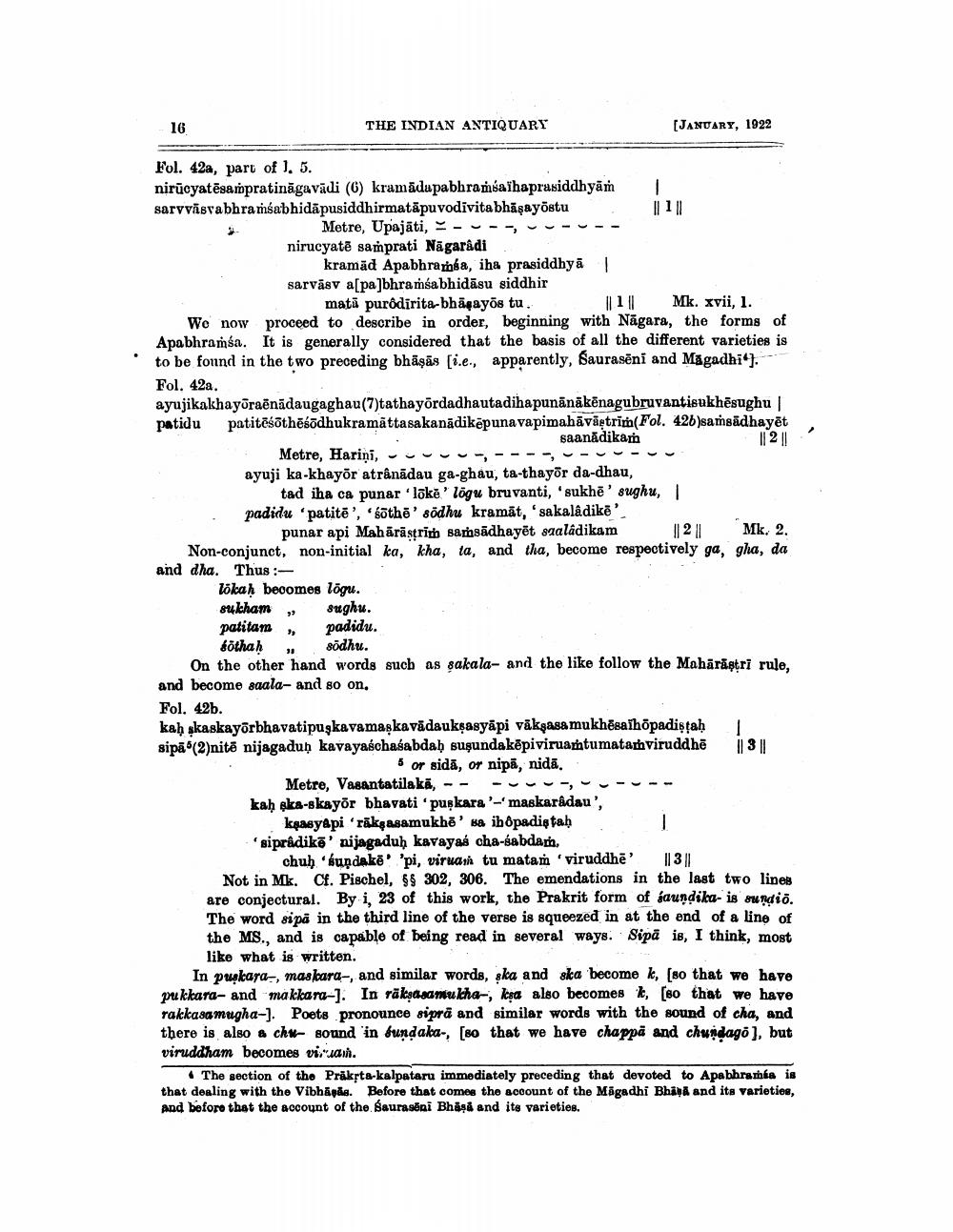________________
16
THE INDIAN ANTIQUARY
(JANUARY, 1922
Fol. 42a, part of I. 5. nirūoyatēsampratinägavädi (6) kramādupabhramsaihaprasiddhyām sarvvisvabhramsabhidāpusiddhirmatäpuvodivita bhäsayõstu Metre, Upajāti, -- --
-- nirucyatē samprati Nāgaradi.
kramăd Apabhramsa, iha prasiddhyā 1 sarvāsv a[pa]bhramsa bhidāsu siddhir matā purðdirita-bhāgayös tu.
||1|| Mk. xvii, 1. We now proceed to describe in order, beginning with Nāgara, the forms of Apabhramśa. It is generally considered that the basis of all the different varieties is to be found in the two preceding bhāşās [i.e., apparently, Saurasēni and Magadhi“). Fol. 42a. ayujikakhayūraēnādaugaghau(7)tathayördadhautadihapunānākēnagubruvantisukhēsughu patidu patitēšothēsõdhukramåttasakanādikepunavapimahāvāętrim(Fol. 426)samsādhayēt
saanădikam
|| 2 || Metre, Harini,
---- ------ ayuji ka-khayör atrânādau ga-ghau, ta-thayor da-dhau,
tad iha ca punar 'lõke' lögu bruvanti, sukhē' sughu, padidu 'patitë', söthö' södhu kramāt, 'sakaládikē'.
punar api Mahārästrim samsādhayēt saalâdikam 21 Mk, 2. Non-conjunct, non-initial ka, kha, ta, and tha, become respectively ga, gha, da and dha. Thus:
lokah beoomes lögu. sulham , sughu. patitam padidu.
föthah , södhu. On the other hand words such as sakala- and the like follow the Mahārāştri rule, and become saala- and so on. Fol. 42b. kah kaskayõrbhavatipuskavamaskavādauksasyāpi vākşasa mukhēsaihopadişah sipā (2)nitë nijagaduh kavayaschasabdaḥ suşundakēpiviruantumatarviruddhë 13
5 or sidā, or nipā, nidā. Metre, Vasantatilakā, -- - -- --- kah gks-skayor bhavati 'puşkara'-maskaradau',
kpasy&pi 'rākşasamukhë' sa ibôpadiştah si pradikê' nijagaduh kavayas cha-sabdan,
chuh kundakē' 'pi, viruan tu mata 'viruddhë' ||3|| Not in Mk. Cf. Pischel, $$ 302, 306. The emendations in the last two lines are conjectural. By i, 23 of this work, the Prakrit form of Saundika- is rundio. The word sipa in the third line of the verse is squeezed in at the end of a line of the MS., and is capable of being read in several ways. Sipā is, I think, most
like what is written.
In pukara-, maskara-, and similar words, ska and ska become k, (so that we have pukkara- and makkara-). In räksasa nuitha kesa also becomes ik, [Bo that we have rakkasamugha-). Poets pronounce siprā and similar words with the sound of cha, and there is also a chu- sound in bundaka-, [so that we have chappa and chundago), but viruddham becomes viisain.
The section of the Präksta-kalpataru immediately preceding that devoted to Apabhramla is that dealing with the Vibhape. Before that comes the account of the Māgadhi BhiA and its varieties, And before that the account of the Sauraseni Bhasa and its varieties.




